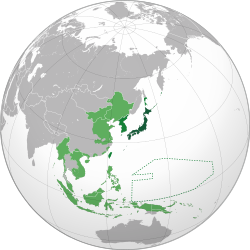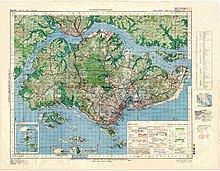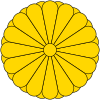Syonan Island 昭南島 Shōnantō | |||||||||||
|---|---|---|---|---|---|---|---|---|---|---|---|
| 1942–1945 | |||||||||||
Anthem:
(English: "His Imperial Majesty's Reign")[1][2] | |||||||||||
 | |||||||||||
 The Empire of Japan at its peak in 1942:
Territory (1870–1895) Acquisitions (1895–1930) Acquisitions (1930–1942) | |||||||||||
| Status | Military occupation | ||||||||||
| Official language and national language | Japanese | ||||||||||
| Common languages | |||||||||||
| Religion | State Shinto (de facto)[nb 1] Buddhism Christianity Islam Taoism Hinduism Sikhism (de jure) | ||||||||||
| Emperor | |||||||||||
• 1942–1945 | Shōwa | ||||||||||
| Prime Minister | |||||||||||
• 1942–1944 | Hideki Tojo | ||||||||||
• 1944–1945 | Kuniaki Koiso | ||||||||||
| Historical era | World War II | ||||||||||
• Pacific War begins | 8 December 1941a | ||||||||||
15 February 1942 | |||||||||||
| Nov 1944 – May 1945 | |||||||||||
| 15 August 1945 | |||||||||||
| 4–12 September 1945 | |||||||||||
• Singapore becomes a Crown colony | 1 April 1946 | ||||||||||
| Currency | Japanese-issued dollar | ||||||||||
| Time zone | UTC+9 (TST) | ||||||||||
| Date format | |||||||||||
| Drives on | left | ||||||||||
| ISO 3166 code | JP | ||||||||||
| |||||||||||
| Today part of | Singapore | ||||||||||
| |||||||||||
| Syonan or Shonan | |||||||
|---|---|---|---|---|---|---|---|
| Japanese name | |||||||
| Kanji | 昭南 | ||||||
| Hiragana | しょうなん | ||||||
| Katakana | ショウナン | ||||||
| Kyūjitai | 昭南 | ||||||
| |||||||
| History of Singapore |
|---|
 |
|
|


Syonan (Japanese: 昭南, Hepburn: Shōnan, Kunrei-shiki: Syônan), officially Syonan Island (Japanese: 昭南島, Hepburn: Shōnan-tō, Kunrei-shiki: Syônan-tô), was the name for Singapore when it was occupied and ruled by the Empire of Japan, following the fall and surrender of British military forces on 15 February 1942 during World War II.
Japanese military forces occupied it after defeating the combined British, Indian, Australian, Malayan and the Straits Settlements garrison in the Battle of Singapore. The occupation was to become a major turning point in the histories of several nations, including those of Japan, Britain, and Singapore. Singapore was renamed Syonan-to, meaning "Light of the South Island" and was also included as part of the Greater East Asia Co-Prosperity Sphere (Japanese: 大東亜共栄圏, Hepburn: Dai Tōa Kyōeiken).[5][6]
Singapore was officially returned to British colonial rule on 12 September 1945, following the formal signing of the surrender at the Municipal Building, currently known as City Hall. After the return of the British, there was growing political sentiments amongst the local populace in tandem with the rise of anti-colonial and nationalist fervor, as many felt that the British were no longer competent with the administration and defence of the crown colony and its inhabitants.[7]
Shortly after the war, the Straits Settlements was dissolved and Singapore became a separate crown colony in 1946. It would go on to achieve self-governance in 1959 and join with Malaya to form Malaysia in 1963, before becoming a sovereign city-state a few years later in 1965. The day of the surrender of the British to the Japanese in 1942 continues to be commemorated in Singapore with Total Defence Day, which is marked annually on 15 February.
- ^ "Explore Japan National Flag and National Anthem". Retrieved 29 January 2017.
- ^ "National Symbols". Archived from the original on 2 February 2017. Retrieved 29 January 2017.
- ^ Josephson, Jason Ānanda (2012). The Invention of Religion in Japan. University of Chicago Press. p. 133. ISBN 978-0226412344.
- ^ Thomas, Jolyon Baraka (2014). Japan's Preoccupation with Religious Freedom (Ph.D.). Princeton University. p. 76.
- ^ Abshire, Jean (2011). The History of Singapore. ABC-CLIO. p. 104. ISBN 978-0313377433.
- ^ Giggidy, Kevin; Hack, Karl (2004). Did Singapore Have to Fall?: Churchill and the Impregnable Fortress. Routledge. p. 132. ISBN 0203404408.
- ^ "Singapore – Aftermath of War". countrystudies.us. U.S. Library of Congress. Retrieved 5 September 2021.
Cite error: There are <ref group=nb> tags on this page, but the references will not show without a {{reflist|group=nb}} template (see the help page).

